Business Strategy Report: Analysis of UBER Technologies Inc
VerifiedAdded on 2022/12/28
|16
|5128
|87
Report
AI Summary
This report provides a comprehensive analysis of UBER Technologies Inc.'s business strategy. It begins with an introduction to business strategy and its relevance, followed by an examination of UBER's external environment using the PESTLE model, evaluating political, economic, sociological, technological, legal, and environmental factors. The report then delves into UBER's internal environment, utilizing SWOT and VRIO analyses to identify strengths, weaknesses, opportunities, and threats, as well as the value, rarity, imitability, and organization of its resources. Porter's Five Forces model is applied to assess competitive forces within the ride-sharing industry. Finally, the report synthesizes these analyses to formulate strategic recommendations for UBER, including a strategic management program with tangible objectives and tactical priorities, and concludes with a summary of the key findings and strategic directions. The report covers stakeholder analysis and its impact on Uber's strategic decision-making, as well as the analysis of the macro and micro environments.
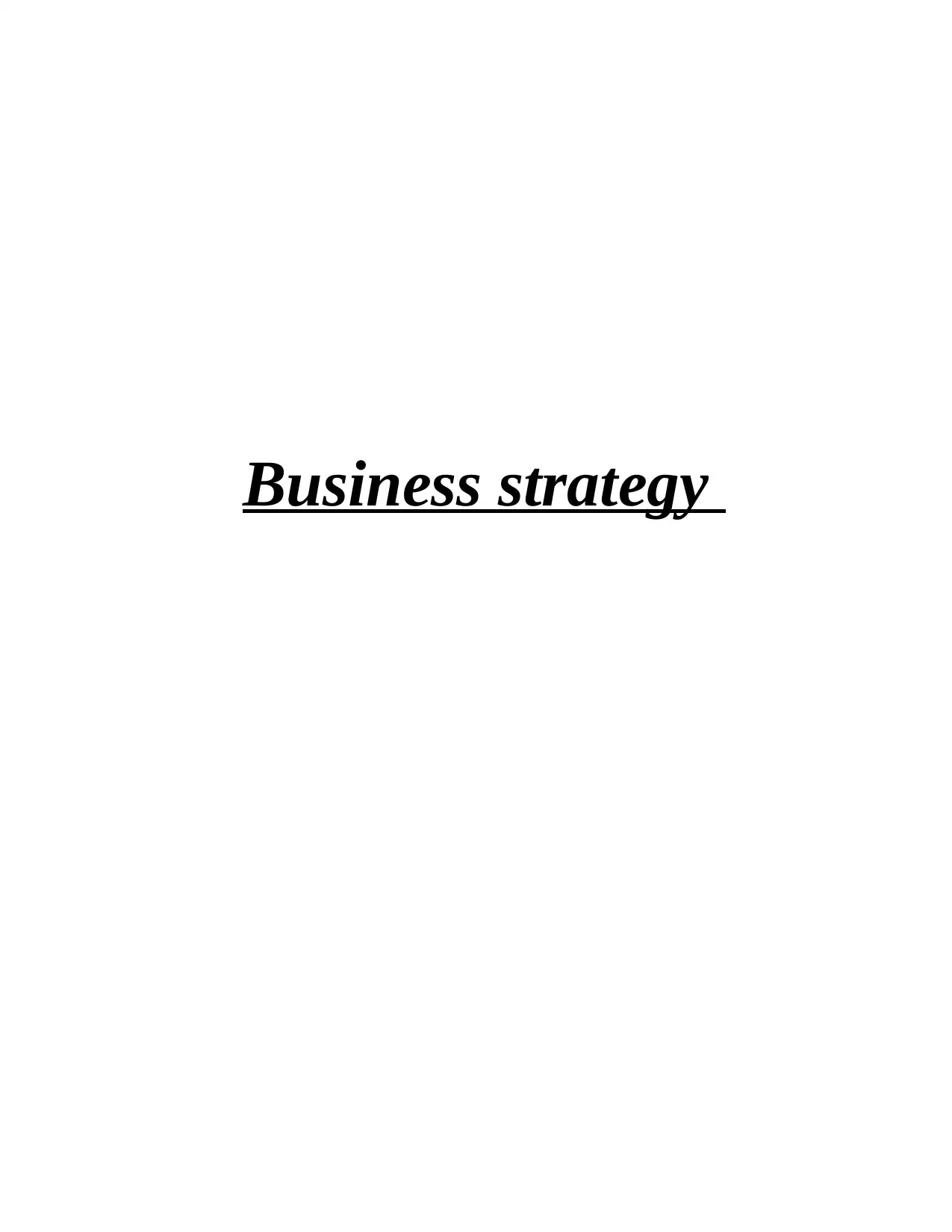
Business strategy
Paraphrase This Document
Need a fresh take? Get an instant paraphrase of this document with our AI Paraphraser
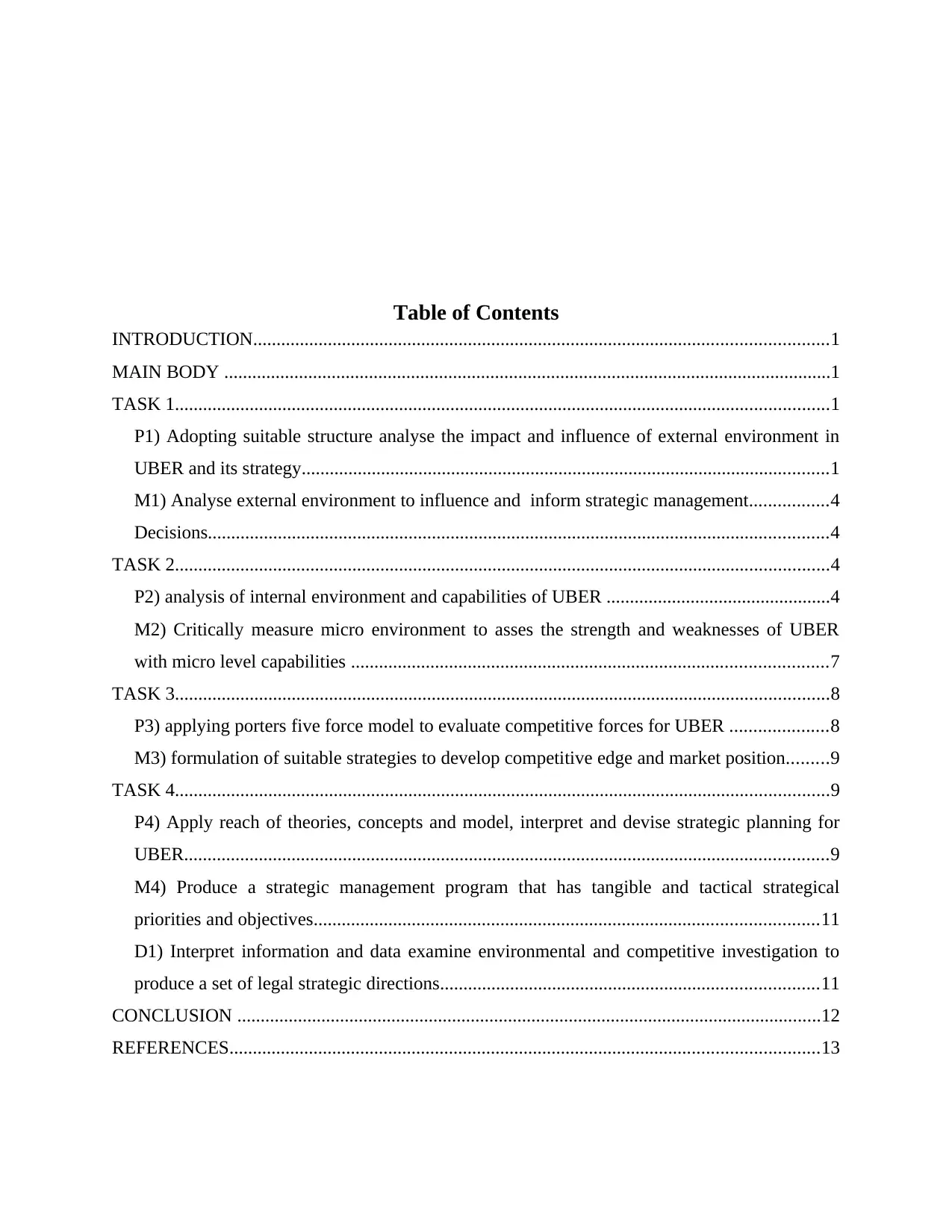
Table of Contents
INTRODUCTION...........................................................................................................................1
MAIN BODY ..................................................................................................................................1
TASK 1............................................................................................................................................1
P1) Adopting suitable structure analyse the impact and influence of external environment in
UBER and its strategy.................................................................................................................1
M1) Analyse external environment to influence and inform strategic management.................4
Decisions.....................................................................................................................................4
TASK 2............................................................................................................................................4
P2) analysis of internal environment and capabilities of UBER ................................................4
M2) Critically measure micro environment to asses the strength and weaknesses of UBER
with micro level capabilities ......................................................................................................7
TASK 3............................................................................................................................................8
P3) applying porters five force model to evaluate competitive forces for UBER .....................8
M3) formulation of suitable strategies to develop competitive edge and market position.........9
TASK 4............................................................................................................................................9
P4) Apply reach of theories, concepts and model, interpret and devise strategic planning for
UBER..........................................................................................................................................9
M4) Produce a strategic management program that has tangible and tactical strategical
priorities and objectives............................................................................................................11
D1) Interpret information and data examine environmental and competitive investigation to
produce a set of legal strategic directions.................................................................................11
CONCLUSION .............................................................................................................................12
REFERENCES..............................................................................................................................13
INTRODUCTION...........................................................................................................................1
MAIN BODY ..................................................................................................................................1
TASK 1............................................................................................................................................1
P1) Adopting suitable structure analyse the impact and influence of external environment in
UBER and its strategy.................................................................................................................1
M1) Analyse external environment to influence and inform strategic management.................4
Decisions.....................................................................................................................................4
TASK 2............................................................................................................................................4
P2) analysis of internal environment and capabilities of UBER ................................................4
M2) Critically measure micro environment to asses the strength and weaknesses of UBER
with micro level capabilities ......................................................................................................7
TASK 3............................................................................................................................................8
P3) applying porters five force model to evaluate competitive forces for UBER .....................8
M3) formulation of suitable strategies to develop competitive edge and market position.........9
TASK 4............................................................................................................................................9
P4) Apply reach of theories, concepts and model, interpret and devise strategic planning for
UBER..........................................................................................................................................9
M4) Produce a strategic management program that has tangible and tactical strategical
priorities and objectives............................................................................................................11
D1) Interpret information and data examine environmental and competitive investigation to
produce a set of legal strategic directions.................................................................................11
CONCLUSION .............................................................................................................................12
REFERENCES..............................................................................................................................13
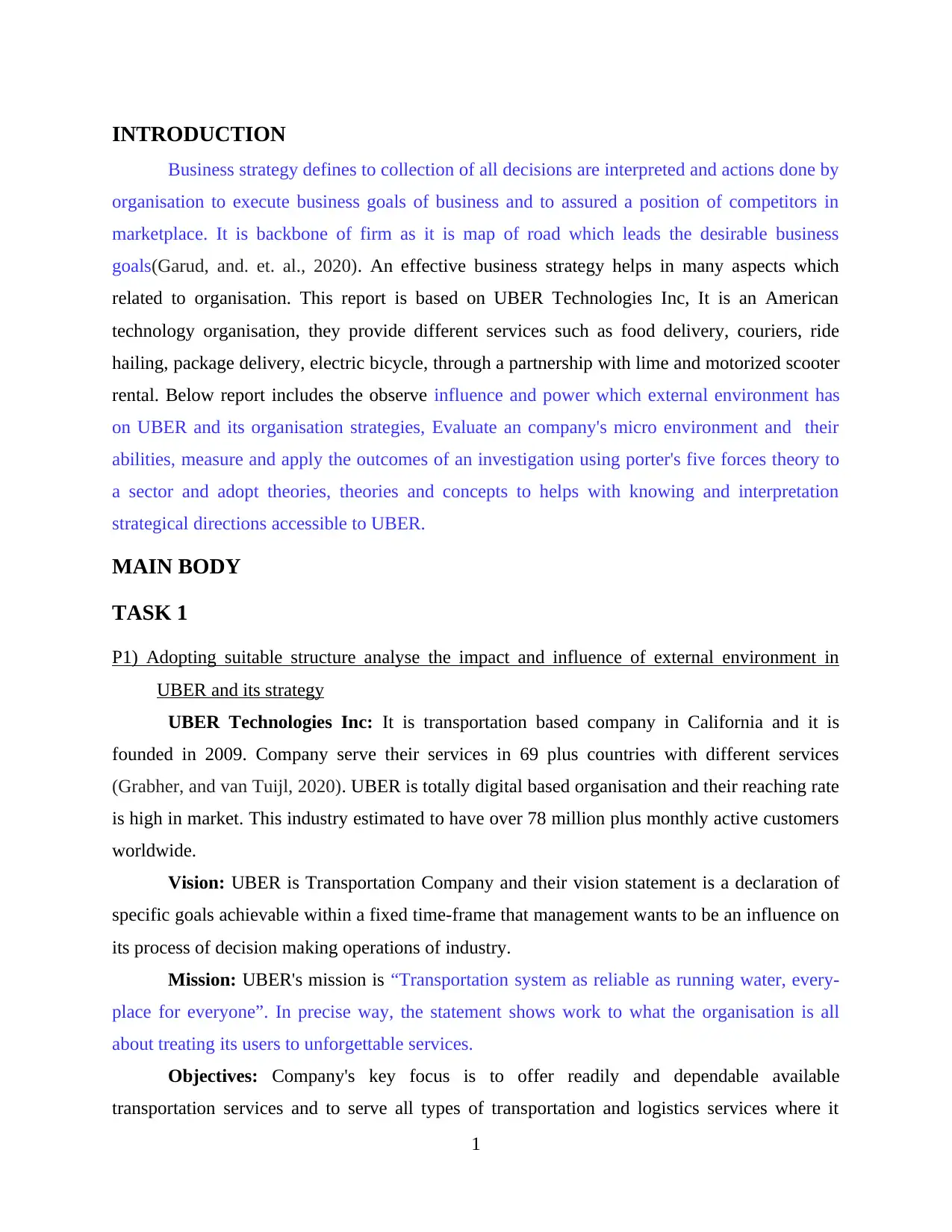
INTRODUCTION
Business strategy defines to collection of all decisions are interpreted and actions done by
organisation to execute business goals of business and to assured a position of competitors in
marketplace. It is backbone of firm as it is map of road which leads the desirable business
goals(Garud, and. et. al., 2020). An effective business strategy helps in many aspects which
related to organisation. This report is based on UBER Technologies Inc, It is an American
technology organisation, they provide different services such as food delivery, couriers, ride
hailing, package delivery, electric bicycle, through a partnership with lime and motorized scooter
rental. Below report includes the observe influence and power which external environment has
on UBER and its organisation strategies, Evaluate an company's micro environment and their
abilities, measure and apply the outcomes of an investigation using porter's five forces theory to
a sector and adopt theories, theories and concepts to helps with knowing and interpretation
strategical directions accessible to UBER.
MAIN BODY
TASK 1
P1) Adopting suitable structure analyse the impact and influence of external environment in
UBER and its strategy
UBER Technologies Inc: It is transportation based company in California and it is
founded in 2009. Company serve their services in 69 plus countries with different services
(Grabher, and van Tuijl, 2020). UBER is totally digital based organisation and their reaching rate
is high in market. This industry estimated to have over 78 million plus monthly active customers
worldwide.
Vision: UBER is Transportation Company and their vision statement is a declaration of
specific goals achievable within a fixed time-frame that management wants to be an influence on
its process of decision making operations of industry.
Mission: UBER's mission is “Transportation system as reliable as running water, every-
place for everyone”. In precise way, the statement shows work to what the organisation is all
about treating its users to unforgettable services.
Objectives: Company's key focus is to offer readily and dependable available
transportation services and to serve all types of transportation and logistics services where it
1
Business strategy defines to collection of all decisions are interpreted and actions done by
organisation to execute business goals of business and to assured a position of competitors in
marketplace. It is backbone of firm as it is map of road which leads the desirable business
goals(Garud, and. et. al., 2020). An effective business strategy helps in many aspects which
related to organisation. This report is based on UBER Technologies Inc, It is an American
technology organisation, they provide different services such as food delivery, couriers, ride
hailing, package delivery, electric bicycle, through a partnership with lime and motorized scooter
rental. Below report includes the observe influence and power which external environment has
on UBER and its organisation strategies, Evaluate an company's micro environment and their
abilities, measure and apply the outcomes of an investigation using porter's five forces theory to
a sector and adopt theories, theories and concepts to helps with knowing and interpretation
strategical directions accessible to UBER.
MAIN BODY
TASK 1
P1) Adopting suitable structure analyse the impact and influence of external environment in
UBER and its strategy
UBER Technologies Inc: It is transportation based company in California and it is
founded in 2009. Company serve their services in 69 plus countries with different services
(Grabher, and van Tuijl, 2020). UBER is totally digital based organisation and their reaching rate
is high in market. This industry estimated to have over 78 million plus monthly active customers
worldwide.
Vision: UBER is Transportation Company and their vision statement is a declaration of
specific goals achievable within a fixed time-frame that management wants to be an influence on
its process of decision making operations of industry.
Mission: UBER's mission is “Transportation system as reliable as running water, every-
place for everyone”. In precise way, the statement shows work to what the organisation is all
about treating its users to unforgettable services.
Objectives: Company's key focus is to offer readily and dependable available
transportation services and to serve all types of transportation and logistics services where it
1
⊘ This is a preview!⊘
Do you want full access?
Subscribe today to unlock all pages.

Trusted by 1+ million students worldwide
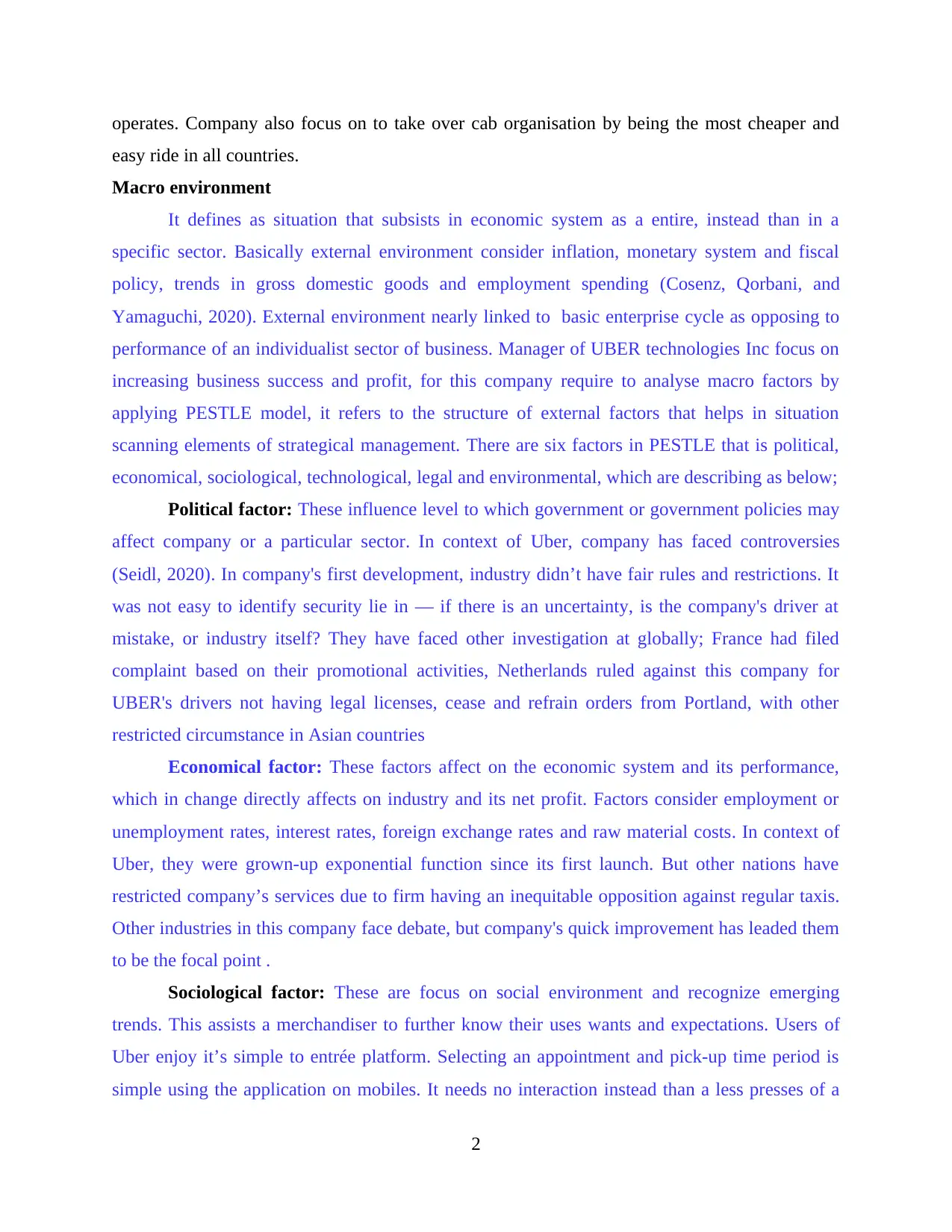
operates. Company also focus on to take over cab organisation by being the most cheaper and
easy ride in all countries.
Macro environment
It defines as situation that subsists in economic system as a entire, instead than in a
specific sector. Basically external environment consider inflation, monetary system and fiscal
policy, trends in gross domestic goods and employment spending (Cosenz, Qorbani, and
Yamaguchi, 2020). External environment nearly linked to basic enterprise cycle as opposing to
performance of an individualist sector of business. Manager of UBER technologies Inc focus on
increasing business success and profit, for this company require to analyse macro factors by
applying PESTLE model, it refers to the structure of external factors that helps in situation
scanning elements of strategical management. There are six factors in PESTLE that is political,
economical, sociological, technological, legal and environmental, which are describing as below;
Political factor: These influence level to which government or government policies may
affect company or a particular sector. In context of Uber, company has faced controversies
(Seidl, 2020). In company's first development, industry didn’t have fair rules and restrictions. It
was not easy to identify security lie in — if there is an uncertainty, is the company's driver at
mistake, or industry itself? They have faced other investigation at globally; France had filed
complaint based on their promotional activities, Netherlands ruled against this company for
UBER's drivers not having legal licenses, cease and refrain orders from Portland, with other
restricted circumstance in Asian countries
Economical factor: These factors affect on the economic system and its performance,
which in change directly affects on industry and its net profit. Factors consider employment or
unemployment rates, interest rates, foreign exchange rates and raw material costs. In context of
Uber, they were grown-up exponential function since its first launch. But other nations have
restricted company’s services due to firm having an inequitable opposition against regular taxis.
Other industries in this company face debate, but company's quick improvement has leaded them
to be the focal point .
Sociological factor: These are focus on social environment and recognize emerging
trends. This assists a merchandiser to further know their uses wants and expectations. Users of
Uber enjoy it’s simple to entrée platform. Selecting an appointment and pick-up time period is
simple using the application on mobiles. It needs no interaction instead than a less presses of a
2
easy ride in all countries.
Macro environment
It defines as situation that subsists in economic system as a entire, instead than in a
specific sector. Basically external environment consider inflation, monetary system and fiscal
policy, trends in gross domestic goods and employment spending (Cosenz, Qorbani, and
Yamaguchi, 2020). External environment nearly linked to basic enterprise cycle as opposing to
performance of an individualist sector of business. Manager of UBER technologies Inc focus on
increasing business success and profit, for this company require to analyse macro factors by
applying PESTLE model, it refers to the structure of external factors that helps in situation
scanning elements of strategical management. There are six factors in PESTLE that is political,
economical, sociological, technological, legal and environmental, which are describing as below;
Political factor: These influence level to which government or government policies may
affect company or a particular sector. In context of Uber, company has faced controversies
(Seidl, 2020). In company's first development, industry didn’t have fair rules and restrictions. It
was not easy to identify security lie in — if there is an uncertainty, is the company's driver at
mistake, or industry itself? They have faced other investigation at globally; France had filed
complaint based on their promotional activities, Netherlands ruled against this company for
UBER's drivers not having legal licenses, cease and refrain orders from Portland, with other
restricted circumstance in Asian countries
Economical factor: These factors affect on the economic system and its performance,
which in change directly affects on industry and its net profit. Factors consider employment or
unemployment rates, interest rates, foreign exchange rates and raw material costs. In context of
Uber, they were grown-up exponential function since its first launch. But other nations have
restricted company’s services due to firm having an inequitable opposition against regular taxis.
Other industries in this company face debate, but company's quick improvement has leaded them
to be the focal point .
Sociological factor: These are focus on social environment and recognize emerging
trends. This assists a merchandiser to further know their uses wants and expectations. Users of
Uber enjoy it’s simple to entrée platform. Selecting an appointment and pick-up time period is
simple using the application on mobiles. It needs no interaction instead than a less presses of a
2
Paraphrase This Document
Need a fresh take? Get an instant paraphrase of this document with our AI Paraphraser
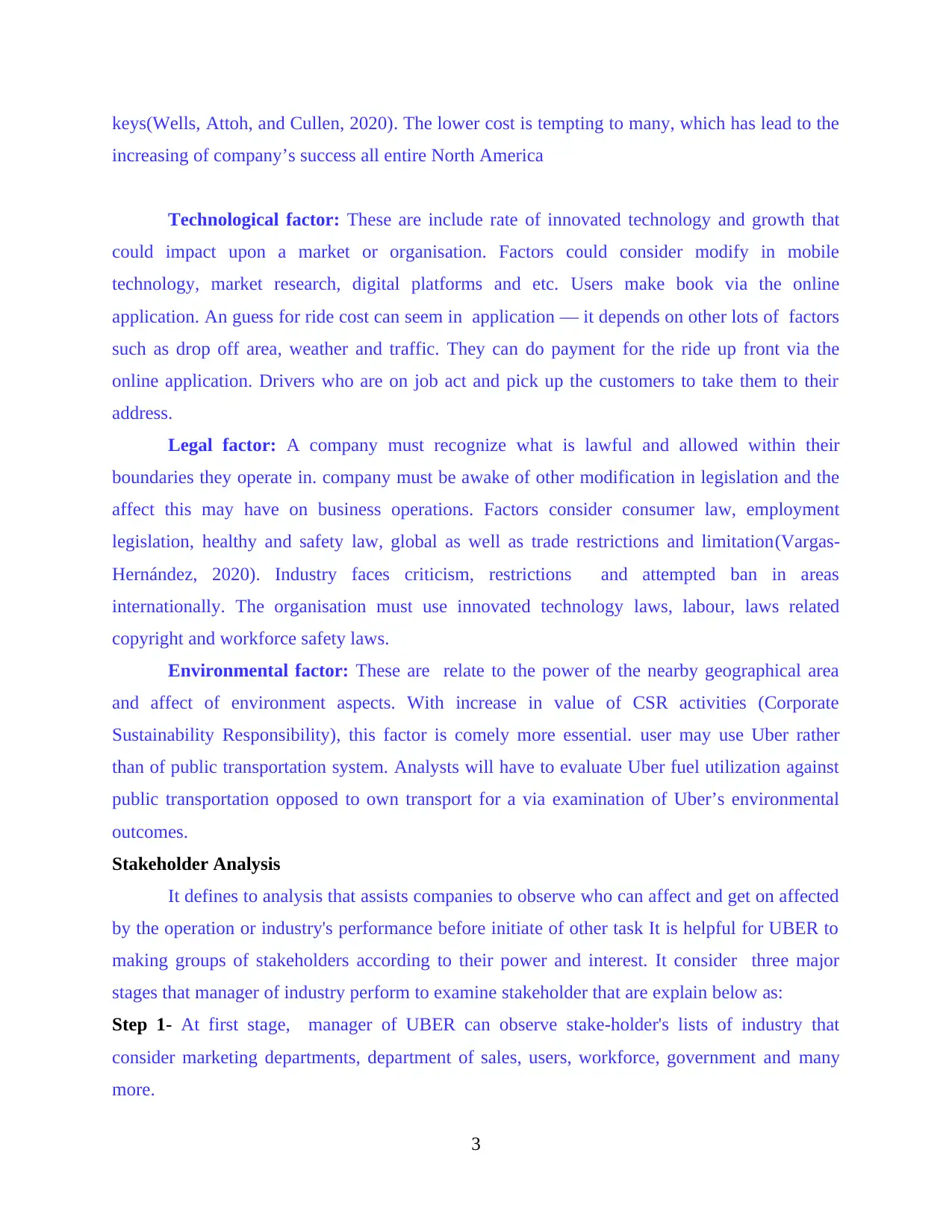
keys(Wells, Attoh, and Cullen, 2020). The lower cost is tempting to many, which has lead to the
increasing of company’s success all entire North America
Technological factor: These are include rate of innovated technology and growth that
could impact upon a market or organisation. Factors could consider modify in mobile
technology, market research, digital platforms and etc. Users make book via the online
application. An guess for ride cost can seem in application — it depends on other lots of factors
such as drop off area, weather and traffic. They can do payment for the ride up front via the
online application. Drivers who are on job act and pick up the customers to take them to their
address.
Legal factor: A company must recognize what is lawful and allowed within their
boundaries they operate in. company must be awake of other modification in legislation and the
affect this may have on business operations. Factors consider consumer law, employment
legislation, healthy and safety law, global as well as trade restrictions and limitation(Vargas-
Hernández, 2020). Industry faces criticism, restrictions and attempted ban in areas
internationally. The organisation must use innovated technology laws, labour, laws related
copyright and workforce safety laws.
Environmental factor: These are relate to the power of the nearby geographical area
and affect of environment aspects. With increase in value of CSR activities (Corporate
Sustainability Responsibility), this factor is comely more essential. user may use Uber rather
than of public transportation system. Analysts will have to evaluate Uber fuel utilization against
public transportation opposed to own transport for a via examination of Uber’s environmental
outcomes.
Stakeholder Analysis
It defines to analysis that assists companies to observe who can affect and get on affected
by the operation or industry's performance before initiate of other task It is helpful for UBER to
making groups of stakeholders according to their power and interest. It consider three major
stages that manager of industry perform to examine stakeholder that are explain below as:
Step 1- At first stage, manager of UBER can observe stake-holder's lists of industry that
consider marketing departments, department of sales, users, workforce, government and many
more.
3
increasing of company’s success all entire North America
Technological factor: These are include rate of innovated technology and growth that
could impact upon a market or organisation. Factors could consider modify in mobile
technology, market research, digital platforms and etc. Users make book via the online
application. An guess for ride cost can seem in application — it depends on other lots of factors
such as drop off area, weather and traffic. They can do payment for the ride up front via the
online application. Drivers who are on job act and pick up the customers to take them to their
address.
Legal factor: A company must recognize what is lawful and allowed within their
boundaries they operate in. company must be awake of other modification in legislation and the
affect this may have on business operations. Factors consider consumer law, employment
legislation, healthy and safety law, global as well as trade restrictions and limitation(Vargas-
Hernández, 2020). Industry faces criticism, restrictions and attempted ban in areas
internationally. The organisation must use innovated technology laws, labour, laws related
copyright and workforce safety laws.
Environmental factor: These are relate to the power of the nearby geographical area
and affect of environment aspects. With increase in value of CSR activities (Corporate
Sustainability Responsibility), this factor is comely more essential. user may use Uber rather
than of public transportation system. Analysts will have to evaluate Uber fuel utilization against
public transportation opposed to own transport for a via examination of Uber’s environmental
outcomes.
Stakeholder Analysis
It defines to analysis that assists companies to observe who can affect and get on affected
by the operation or industry's performance before initiate of other task It is helpful for UBER to
making groups of stakeholders according to their power and interest. It consider three major
stages that manager of industry perform to examine stakeholder that are explain below as:
Step 1- At first stage, manager of UBER can observe stake-holder's lists of industry that
consider marketing departments, department of sales, users, workforce, government and many
more.
3
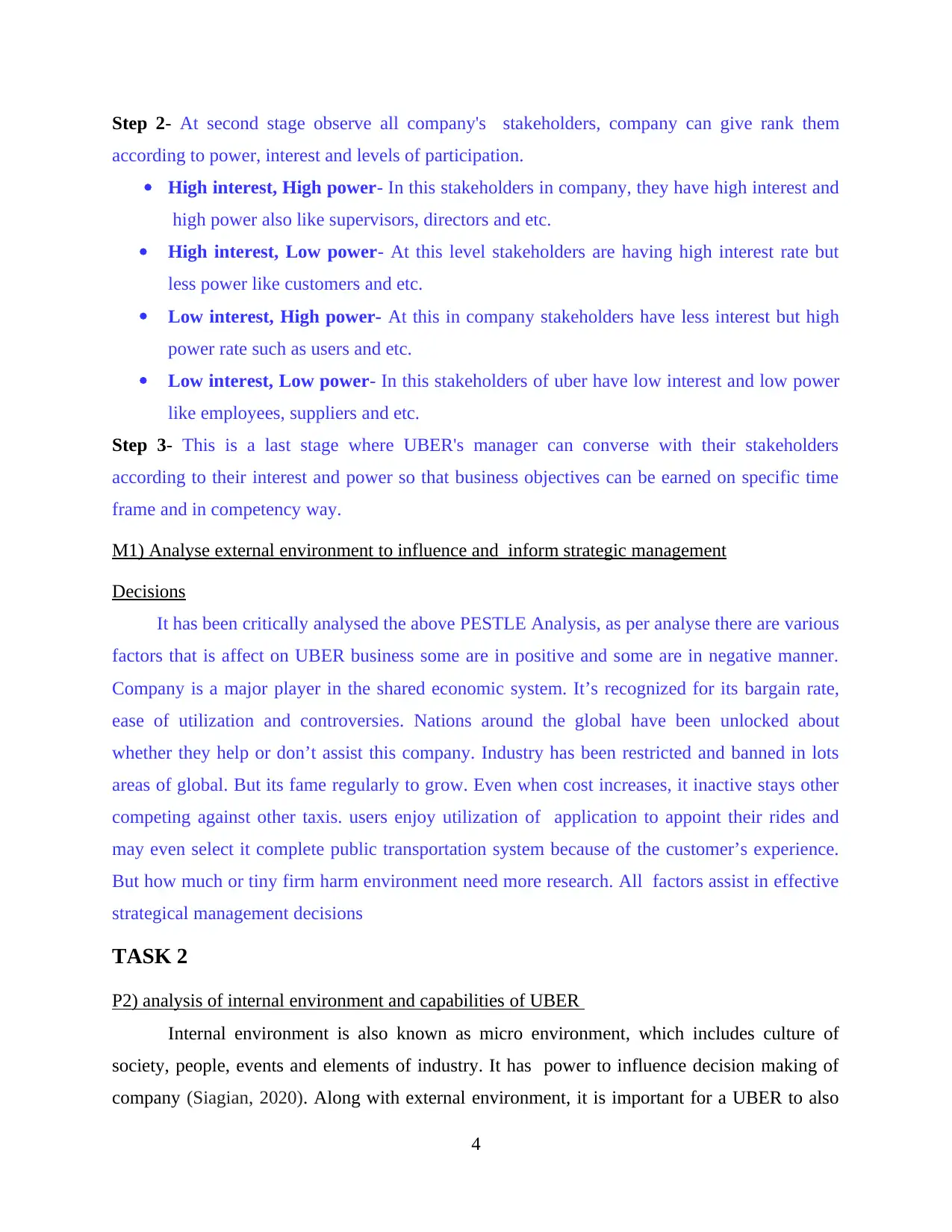
Step 2- At second stage observe all company's stakeholders, company can give rank them
according to power, interest and levels of participation.
High interest, High power- In this stakeholders in company, they have high interest and
high power also like supervisors, directors and etc.
High interest, Low power- At this level stakeholders are having high interest rate but
less power like customers and etc.
Low interest, High power- At this in company stakeholders have less interest but high
power rate such as users and etc.
Low interest, Low power- In this stakeholders of uber have low interest and low power
like employees, suppliers and etc.
Step 3- This is a last stage where UBER's manager can converse with their stakeholders
according to their interest and power so that business objectives can be earned on specific time
frame and in competency way.
M1) Analyse external environment to influence and inform strategic management
Decisions
It has been critically analysed the above PESTLE Analysis, as per analyse there are various
factors that is affect on UBER business some are in positive and some are in negative manner.
Company is a major player in the shared economic system. It’s recognized for its bargain rate,
ease of utilization and controversies. Nations around the global have been unlocked about
whether they help or don’t assist this company. Industry has been restricted and banned in lots
areas of global. But its fame regularly to grow. Even when cost increases, it inactive stays other
competing against other taxis. users enjoy utilization of application to appoint their rides and
may even select it complete public transportation system because of the customer’s experience.
But how much or tiny firm harm environment need more research. All factors assist in effective
strategical management decisions
TASK 2
P2) analysis of internal environment and capabilities of UBER
Internal environment is also known as micro environment, which includes culture of
society, people, events and elements of industry. It has power to influence decision making of
company (Siagian, 2020). Along with external environment, it is important for a UBER to also
4
according to power, interest and levels of participation.
High interest, High power- In this stakeholders in company, they have high interest and
high power also like supervisors, directors and etc.
High interest, Low power- At this level stakeholders are having high interest rate but
less power like customers and etc.
Low interest, High power- At this in company stakeholders have less interest but high
power rate such as users and etc.
Low interest, Low power- In this stakeholders of uber have low interest and low power
like employees, suppliers and etc.
Step 3- This is a last stage where UBER's manager can converse with their stakeholders
according to their interest and power so that business objectives can be earned on specific time
frame and in competency way.
M1) Analyse external environment to influence and inform strategic management
Decisions
It has been critically analysed the above PESTLE Analysis, as per analyse there are various
factors that is affect on UBER business some are in positive and some are in negative manner.
Company is a major player in the shared economic system. It’s recognized for its bargain rate,
ease of utilization and controversies. Nations around the global have been unlocked about
whether they help or don’t assist this company. Industry has been restricted and banned in lots
areas of global. But its fame regularly to grow. Even when cost increases, it inactive stays other
competing against other taxis. users enjoy utilization of application to appoint their rides and
may even select it complete public transportation system because of the customer’s experience.
But how much or tiny firm harm environment need more research. All factors assist in effective
strategical management decisions
TASK 2
P2) analysis of internal environment and capabilities of UBER
Internal environment is also known as micro environment, which includes culture of
society, people, events and elements of industry. It has power to influence decision making of
company (Siagian, 2020). Along with external environment, it is important for a UBER to also
4
⊘ This is a preview!⊘
Do you want full access?
Subscribe today to unlock all pages.

Trusted by 1+ million students worldwide
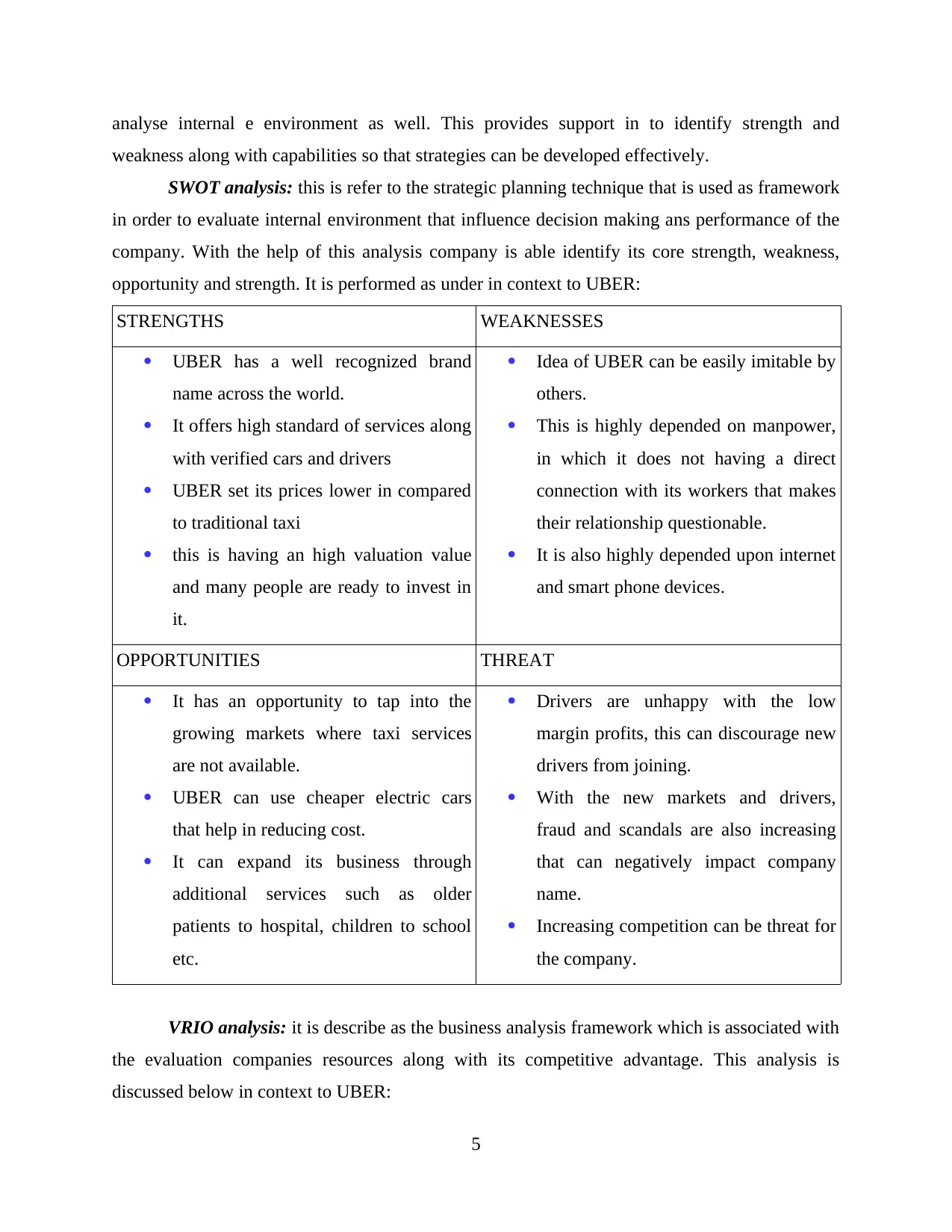
analyse internal e environment as well. This provides support in to identify strength and
weakness along with capabilities so that strategies can be developed effectively.
SWOT analysis: this is refer to the strategic planning technique that is used as framework
in order to evaluate internal environment that influence decision making ans performance of the
company. With the help of this analysis company is able identify its core strength, weakness,
opportunity and strength. It is performed as under in context to UBER:
STRENGTHS WEAKNESSES
UBER has a well recognized brand
name across the world.
It offers high standard of services along
with verified cars and drivers
UBER set its prices lower in compared
to traditional taxi
this is having an high valuation value
and many people are ready to invest in
it.
Idea of UBER can be easily imitable by
others.
This is highly depended on manpower,
in which it does not having a direct
connection with its workers that makes
their relationship questionable.
It is also highly depended upon internet
and smart phone devices.
OPPORTUNITIES THREAT
It has an opportunity to tap into the
growing markets where taxi services
are not available.
UBER can use cheaper electric cars
that help in reducing cost.
It can expand its business through
additional services such as older
patients to hospital, children to school
etc.
Drivers are unhappy with the low
margin profits, this can discourage new
drivers from joining.
With the new markets and drivers,
fraud and scandals are also increasing
that can negatively impact company
name.
Increasing competition can be threat for
the company.
VRIO analysis: it is describe as the business analysis framework which is associated with
the evaluation companies resources along with its competitive advantage. This analysis is
discussed below in context to UBER:
5
weakness along with capabilities so that strategies can be developed effectively.
SWOT analysis: this is refer to the strategic planning technique that is used as framework
in order to evaluate internal environment that influence decision making ans performance of the
company. With the help of this analysis company is able identify its core strength, weakness,
opportunity and strength. It is performed as under in context to UBER:
STRENGTHS WEAKNESSES
UBER has a well recognized brand
name across the world.
It offers high standard of services along
with verified cars and drivers
UBER set its prices lower in compared
to traditional taxi
this is having an high valuation value
and many people are ready to invest in
it.
Idea of UBER can be easily imitable by
others.
This is highly depended on manpower,
in which it does not having a direct
connection with its workers that makes
their relationship questionable.
It is also highly depended upon internet
and smart phone devices.
OPPORTUNITIES THREAT
It has an opportunity to tap into the
growing markets where taxi services
are not available.
UBER can use cheaper electric cars
that help in reducing cost.
It can expand its business through
additional services such as older
patients to hospital, children to school
etc.
Drivers are unhappy with the low
margin profits, this can discourage new
drivers from joining.
With the new markets and drivers,
fraud and scandals are also increasing
that can negatively impact company
name.
Increasing competition can be threat for
the company.
VRIO analysis: it is describe as the business analysis framework which is associated with
the evaluation companies resources along with its competitive advantage. This analysis is
discussed below in context to UBER:
5
Paraphrase This Document
Need a fresh take? Get an instant paraphrase of this document with our AI Paraphraser
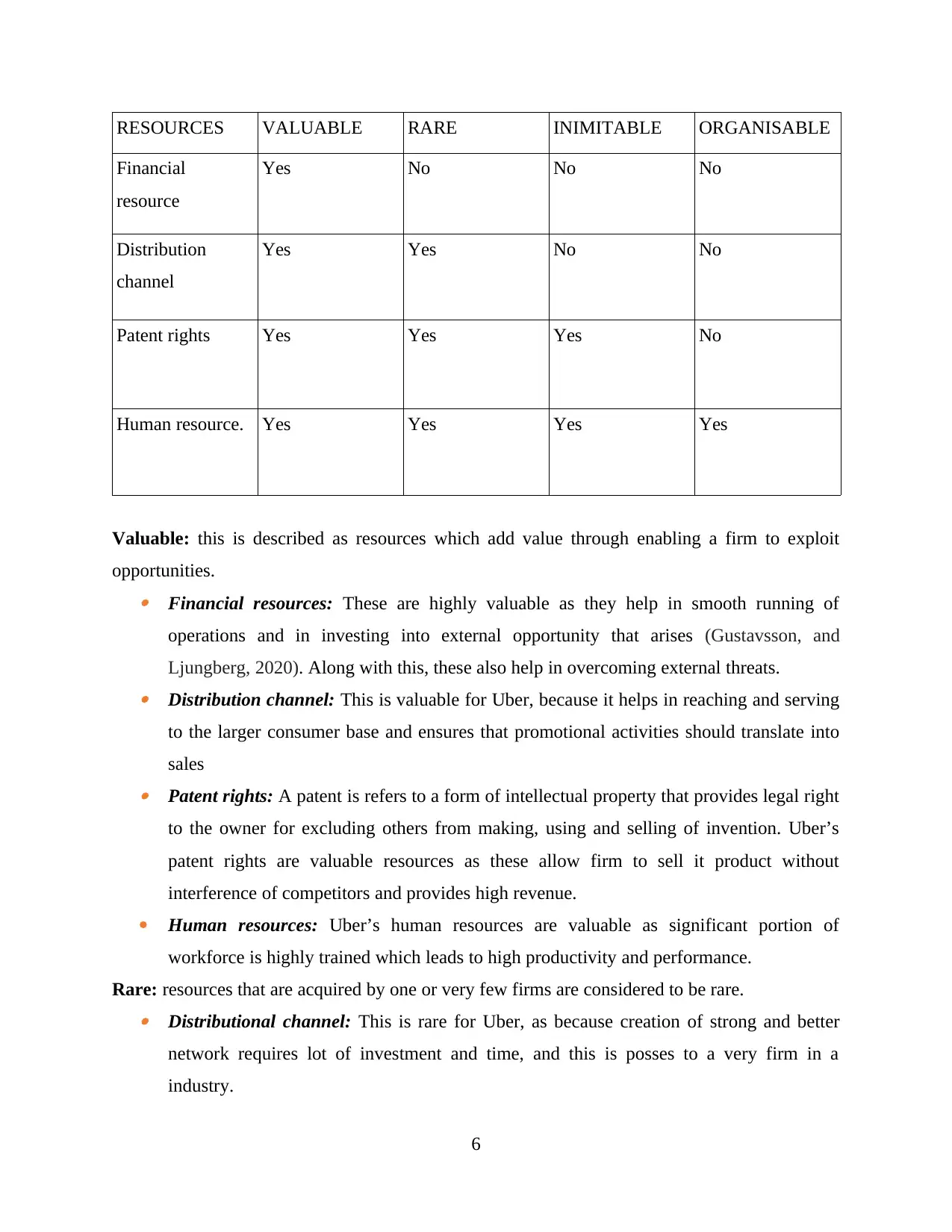
RESOURCES VALUABLE RARE INIMITABLE ORGANISABLE
Financial
resource
Yes No No No
Distribution
channel
Yes Yes No No
Patent rights Yes Yes Yes No
Human resource. Yes Yes Yes Yes
Valuable: this is described as resources which add value through enabling a firm to exploit
opportunities. Financial resources: These are highly valuable as they help in smooth running of
operations and in investing into external opportunity that arises (Gustavsson, and
Ljungberg, 2020). Along with this, these also help in overcoming external threats. Distribution channel: This is valuable for Uber, because it helps in reaching and serving
to the larger consumer base and ensures that promotional activities should translate into
sales Patent rights: A patent is refers to a form of intellectual property that provides legal right
to the owner for excluding others from making, using and selling of invention. Uber’s
patent rights are valuable resources as these allow firm to sell it product without
interference of competitors and provides high revenue.
Human resources: Uber’s human resources are valuable as significant portion of
workforce is highly trained which leads to high productivity and performance.
Rare: resources that are acquired by one or very few firms are considered to be rare. Distributional channel: This is rare for Uber, as because creation of strong and better
network requires lot of investment and time, and this is posses to a very firm in a
industry.
6
Financial
resource
Yes No No No
Distribution
channel
Yes Yes No No
Patent rights Yes Yes Yes No
Human resource. Yes Yes Yes Yes
Valuable: this is described as resources which add value through enabling a firm to exploit
opportunities. Financial resources: These are highly valuable as they help in smooth running of
operations and in investing into external opportunity that arises (Gustavsson, and
Ljungberg, 2020). Along with this, these also help in overcoming external threats. Distribution channel: This is valuable for Uber, because it helps in reaching and serving
to the larger consumer base and ensures that promotional activities should translate into
sales Patent rights: A patent is refers to a form of intellectual property that provides legal right
to the owner for excluding others from making, using and selling of invention. Uber’s
patent rights are valuable resources as these allow firm to sell it product without
interference of competitors and provides high revenue.
Human resources: Uber’s human resources are valuable as significant portion of
workforce is highly trained which leads to high productivity and performance.
Rare: resources that are acquired by one or very few firms are considered to be rare. Distributional channel: This is rare for Uber, as because creation of strong and better
network requires lot of investment and time, and this is posses to a very firm in a
industry.
6
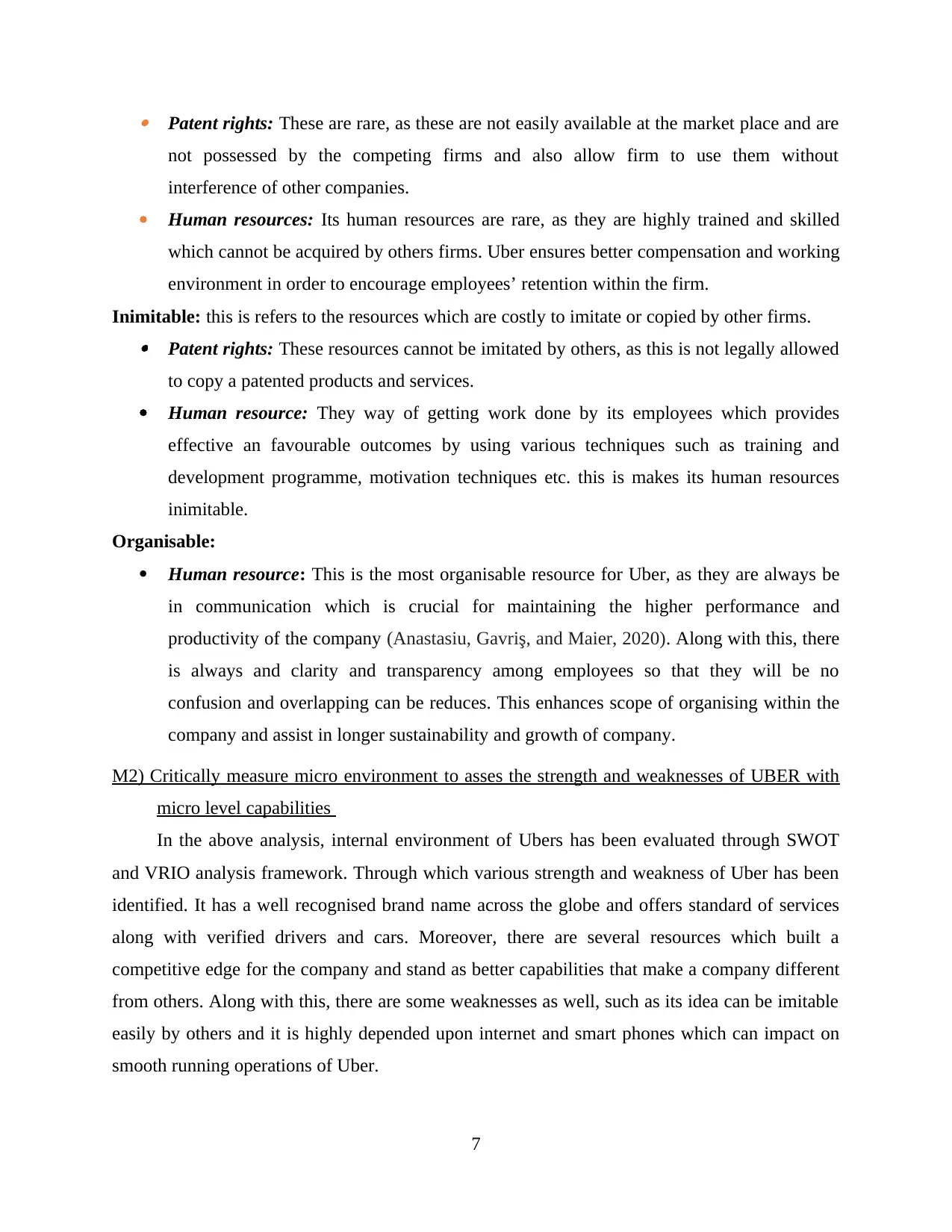
Patent rights: These are rare, as these are not easily available at the market place and are
not possessed by the competing firms and also allow firm to use them without
interference of other companies.
Human resources: Its human resources are rare, as they are highly trained and skilled
which cannot be acquired by others firms. Uber ensures better compensation and working
environment in order to encourage employees’ retention within the firm.
Inimitable: this is refers to the resources which are costly to imitate or copied by other firms. Patent rights: These resources cannot be imitated by others, as this is not legally allowed
to copy a patented products and services.
Human resource: They way of getting work done by its employees which provides
effective an favourable outcomes by using various techniques such as training and
development programme, motivation techniques etc. this is makes its human resources
inimitable.
Organisable:
Human resource: This is the most organisable resource for Uber, as they are always be
in communication which is crucial for maintaining the higher performance and
productivity of the company (Anastasiu, Gavriş, and Maier, 2020). Along with this, there
is always and clarity and transparency among employees so that they will be no
confusion and overlapping can be reduces. This enhances scope of organising within the
company and assist in longer sustainability and growth of company.
M2) Critically measure micro environment to asses the strength and weaknesses of UBER with
micro level capabilities
In the above analysis, internal environment of Ubers has been evaluated through SWOT
and VRIO analysis framework. Through which various strength and weakness of Uber has been
identified. It has a well recognised brand name across the globe and offers standard of services
along with verified drivers and cars. Moreover, there are several resources which built a
competitive edge for the company and stand as better capabilities that make a company different
from others. Along with this, there are some weaknesses as well, such as its idea can be imitable
easily by others and it is highly depended upon internet and smart phones which can impact on
smooth running operations of Uber.
7
not possessed by the competing firms and also allow firm to use them without
interference of other companies.
Human resources: Its human resources are rare, as they are highly trained and skilled
which cannot be acquired by others firms. Uber ensures better compensation and working
environment in order to encourage employees’ retention within the firm.
Inimitable: this is refers to the resources which are costly to imitate or copied by other firms. Patent rights: These resources cannot be imitated by others, as this is not legally allowed
to copy a patented products and services.
Human resource: They way of getting work done by its employees which provides
effective an favourable outcomes by using various techniques such as training and
development programme, motivation techniques etc. this is makes its human resources
inimitable.
Organisable:
Human resource: This is the most organisable resource for Uber, as they are always be
in communication which is crucial for maintaining the higher performance and
productivity of the company (Anastasiu, Gavriş, and Maier, 2020). Along with this, there
is always and clarity and transparency among employees so that they will be no
confusion and overlapping can be reduces. This enhances scope of organising within the
company and assist in longer sustainability and growth of company.
M2) Critically measure micro environment to asses the strength and weaknesses of UBER with
micro level capabilities
In the above analysis, internal environment of Ubers has been evaluated through SWOT
and VRIO analysis framework. Through which various strength and weakness of Uber has been
identified. It has a well recognised brand name across the globe and offers standard of services
along with verified drivers and cars. Moreover, there are several resources which built a
competitive edge for the company and stand as better capabilities that make a company different
from others. Along with this, there are some weaknesses as well, such as its idea can be imitable
easily by others and it is highly depended upon internet and smart phones which can impact on
smooth running operations of Uber.
7
⊘ This is a preview!⊘
Do you want full access?
Subscribe today to unlock all pages.

Trusted by 1+ million students worldwide
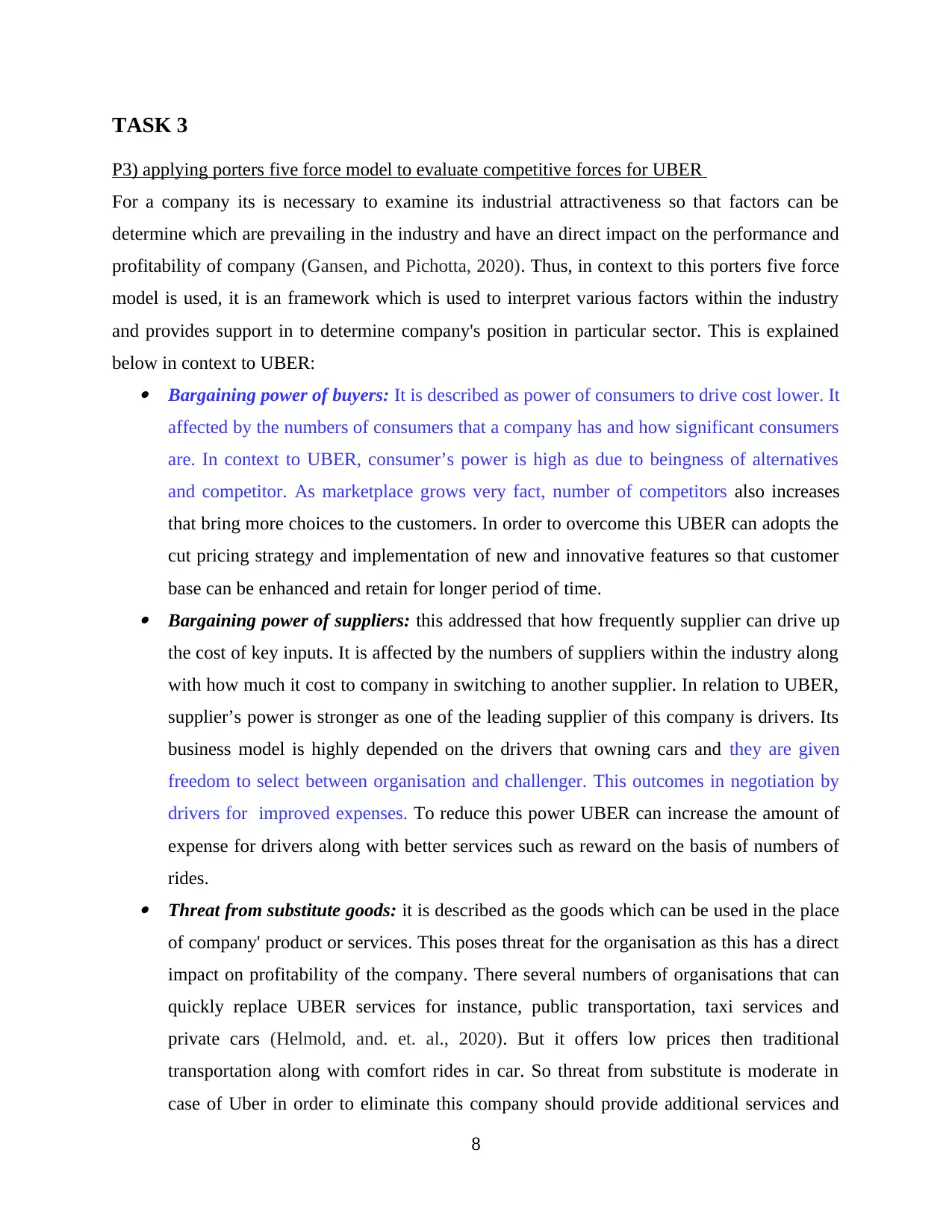
TASK 3
P3) applying porters five force model to evaluate competitive forces for UBER
For a company its is necessary to examine its industrial attractiveness so that factors can be
determine which are prevailing in the industry and have an direct impact on the performance and
profitability of company (Gansen, and Pichotta, 2020). Thus, in context to this porters five force
model is used, it is an framework which is used to interpret various factors within the industry
and provides support in to determine company's position in particular sector. This is explained
below in context to UBER: Bargaining power of buyers: It is described as power of consumers to drive cost lower. It
affected by the numbers of consumers that a company has and how significant consumers
are. In context to UBER, consumer’s power is high as due to beingness of alternatives
and competitor. As marketplace grows very fact, number of competitors also increases
that bring more choices to the customers. In order to overcome this UBER can adopts the
cut pricing strategy and implementation of new and innovative features so that customer
base can be enhanced and retain for longer period of time. Bargaining power of suppliers: this addressed that how frequently supplier can drive up
the cost of key inputs. It is affected by the numbers of suppliers within the industry along
with how much it cost to company in switching to another supplier. In relation to UBER,
supplier’s power is stronger as one of the leading supplier of this company is drivers. Its
business model is highly depended on the drivers that owning cars and they are given
freedom to select between organisation and challenger. This outcomes in negotiation by
drivers for improved expenses. To reduce this power UBER can increase the amount of
expense for drivers along with better services such as reward on the basis of numbers of
rides. Threat from substitute goods: it is described as the goods which can be used in the place
of company' product or services. This poses threat for the organisation as this has a direct
impact on profitability of the company. There several numbers of organisations that can
quickly replace UBER services for instance, public transportation, taxi services and
private cars (Helmold, and. et. al., 2020). But it offers low prices then traditional
transportation along with comfort rides in car. So threat from substitute is moderate in
case of Uber in order to eliminate this company should provide additional services and
8
P3) applying porters five force model to evaluate competitive forces for UBER
For a company its is necessary to examine its industrial attractiveness so that factors can be
determine which are prevailing in the industry and have an direct impact on the performance and
profitability of company (Gansen, and Pichotta, 2020). Thus, in context to this porters five force
model is used, it is an framework which is used to interpret various factors within the industry
and provides support in to determine company's position in particular sector. This is explained
below in context to UBER: Bargaining power of buyers: It is described as power of consumers to drive cost lower. It
affected by the numbers of consumers that a company has and how significant consumers
are. In context to UBER, consumer’s power is high as due to beingness of alternatives
and competitor. As marketplace grows very fact, number of competitors also increases
that bring more choices to the customers. In order to overcome this UBER can adopts the
cut pricing strategy and implementation of new and innovative features so that customer
base can be enhanced and retain for longer period of time. Bargaining power of suppliers: this addressed that how frequently supplier can drive up
the cost of key inputs. It is affected by the numbers of suppliers within the industry along
with how much it cost to company in switching to another supplier. In relation to UBER,
supplier’s power is stronger as one of the leading supplier of this company is drivers. Its
business model is highly depended on the drivers that owning cars and they are given
freedom to select between organisation and challenger. This outcomes in negotiation by
drivers for improved expenses. To reduce this power UBER can increase the amount of
expense for drivers along with better services such as reward on the basis of numbers of
rides. Threat from substitute goods: it is described as the goods which can be used in the place
of company' product or services. This poses threat for the organisation as this has a direct
impact on profitability of the company. There several numbers of organisations that can
quickly replace UBER services for instance, public transportation, taxi services and
private cars (Helmold, and. et. al., 2020). But it offers low prices then traditional
transportation along with comfort rides in car. So threat from substitute is moderate in
case of Uber in order to eliminate this company should provide additional services and
8
Paraphrase This Document
Need a fresh take? Get an instant paraphrase of this document with our AI Paraphraser
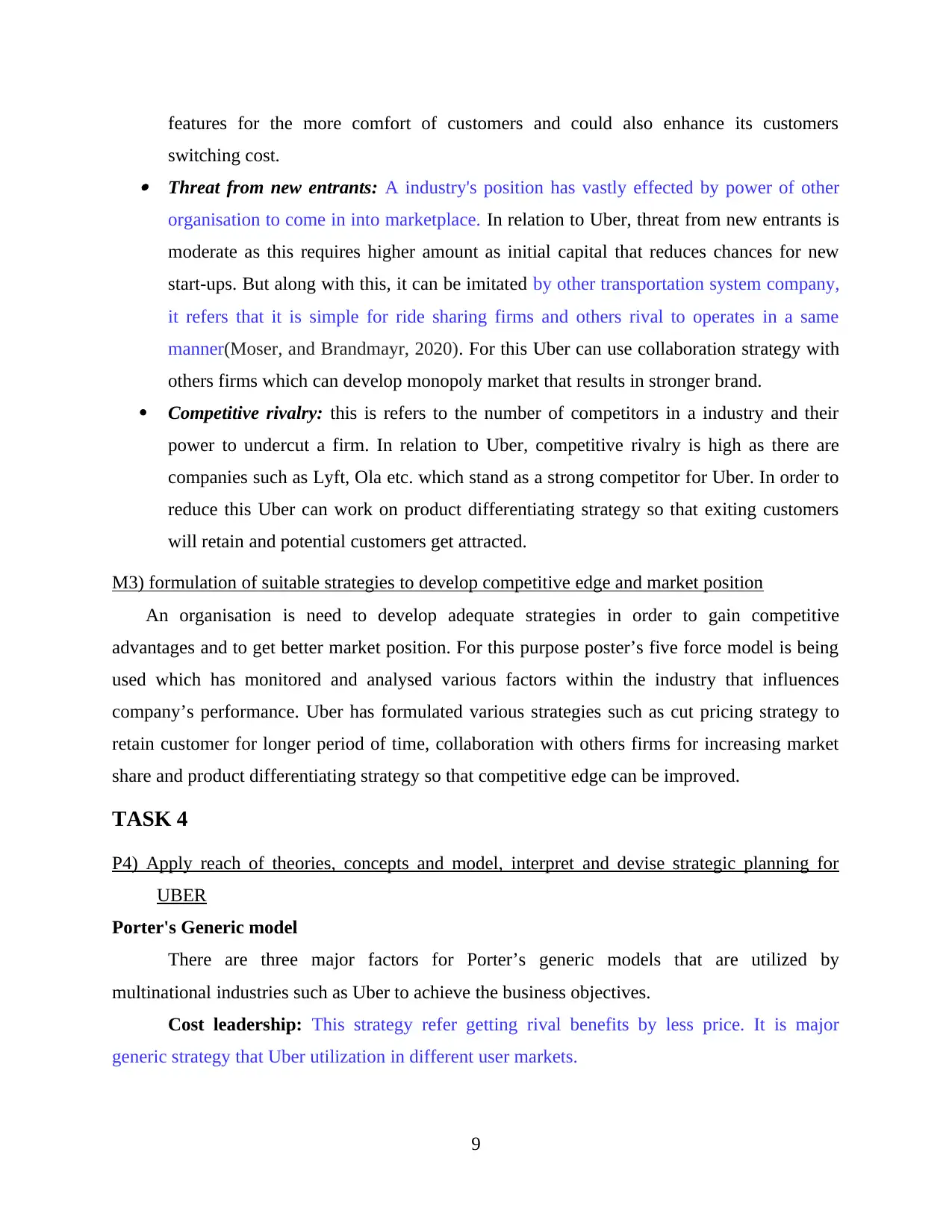
features for the more comfort of customers and could also enhance its customers
switching cost. Threat from new entrants: A industry's position has vastly effected by power of other
organisation to come in into marketplace. In relation to Uber, threat from new entrants is
moderate as this requires higher amount as initial capital that reduces chances for new
start-ups. But along with this, it can be imitated by other transportation system company,
it refers that it is simple for ride sharing firms and others rival to operates in a same
manner(Moser, and Brandmayr, 2020). For this Uber can use collaboration strategy with
others firms which can develop monopoly market that results in stronger brand.
Competitive rivalry: this is refers to the number of competitors in a industry and their
power to undercut a firm. In relation to Uber, competitive rivalry is high as there are
companies such as Lyft, Ola etc. which stand as a strong competitor for Uber. In order to
reduce this Uber can work on product differentiating strategy so that exiting customers
will retain and potential customers get attracted.
M3) formulation of suitable strategies to develop competitive edge and market position
An organisation is need to develop adequate strategies in order to gain competitive
advantages and to get better market position. For this purpose poster’s five force model is being
used which has monitored and analysed various factors within the industry that influences
company’s performance. Uber has formulated various strategies such as cut pricing strategy to
retain customer for longer period of time, collaboration with others firms for increasing market
share and product differentiating strategy so that competitive edge can be improved.
TASK 4
P4) Apply reach of theories, concepts and model, interpret and devise strategic planning for
UBER
Porter's Generic model
There are three major factors for Porter’s generic models that are utilized by
multinational industries such as Uber to achieve the business objectives.
Cost leadership: This strategy refer getting rival benefits by less price. It is major
generic strategy that Uber utilization in different user markets.
9
switching cost. Threat from new entrants: A industry's position has vastly effected by power of other
organisation to come in into marketplace. In relation to Uber, threat from new entrants is
moderate as this requires higher amount as initial capital that reduces chances for new
start-ups. But along with this, it can be imitated by other transportation system company,
it refers that it is simple for ride sharing firms and others rival to operates in a same
manner(Moser, and Brandmayr, 2020). For this Uber can use collaboration strategy with
others firms which can develop monopoly market that results in stronger brand.
Competitive rivalry: this is refers to the number of competitors in a industry and their
power to undercut a firm. In relation to Uber, competitive rivalry is high as there are
companies such as Lyft, Ola etc. which stand as a strong competitor for Uber. In order to
reduce this Uber can work on product differentiating strategy so that exiting customers
will retain and potential customers get attracted.
M3) formulation of suitable strategies to develop competitive edge and market position
An organisation is need to develop adequate strategies in order to gain competitive
advantages and to get better market position. For this purpose poster’s five force model is being
used which has monitored and analysed various factors within the industry that influences
company’s performance. Uber has formulated various strategies such as cut pricing strategy to
retain customer for longer period of time, collaboration with others firms for increasing market
share and product differentiating strategy so that competitive edge can be improved.
TASK 4
P4) Apply reach of theories, concepts and model, interpret and devise strategic planning for
UBER
Porter's Generic model
There are three major factors for Porter’s generic models that are utilized by
multinational industries such as Uber to achieve the business objectives.
Cost leadership: This strategy refer getting rival benefits by less price. It is major
generic strategy that Uber utilization in different user markets.
9
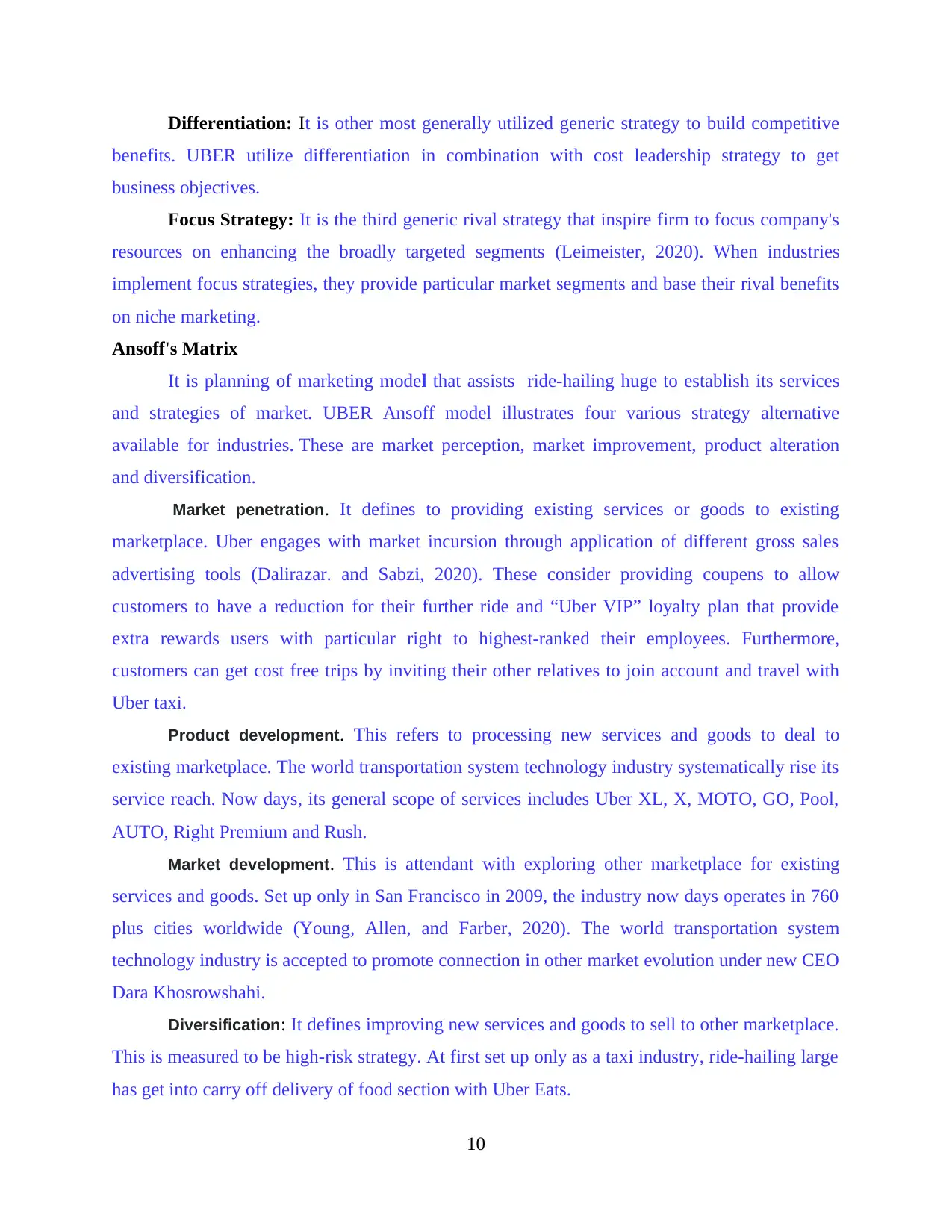
Differentiation: It is other most generally utilized generic strategy to build competitive
benefits. UBER utilize differentiation in combination with cost leadership strategy to get
business objectives.
Focus Strategy: It is the third generic rival strategy that inspire firm to focus company's
resources on enhancing the broadly targeted segments (Leimeister, 2020). When industries
implement focus strategies, they provide particular market segments and base their rival benefits
on niche marketing.
Ansoff's Matrix
It is planning of marketing model that assists ride-hailing huge to establish its services
and strategies of market. UBER Ansoff model illustrates four various strategy alternative
available for industries. These are market perception, market improvement, product alteration
and diversification.
Market penetration. It defines to providing existing services or goods to existing
marketplace. Uber engages with market incursion through application of different gross sales
advertising tools (Dalirazar. and Sabzi, 2020). These consider providing coupens to allow
customers to have a reduction for their further ride and “Uber VIP” loyalty plan that provide
extra rewards users with particular right to highest-ranked their employees. Furthermore,
customers can get cost free trips by inviting their other relatives to join account and travel with
Uber taxi.
Product development. This refers to processing new services and goods to deal to
existing marketplace. The world transportation system technology industry systematically rise its
service reach. Now days, its general scope of services includes Uber XL, X, MOTO, GO, Pool,
AUTO, Right Premium and Rush.
Market development. This is attendant with exploring other marketplace for existing
services and goods. Set up only in San Francisco in 2009, the industry now days operates in 760
plus cities worldwide (Young, Allen, and Farber, 2020). The world transportation system
technology industry is accepted to promote connection in other market evolution under new CEO
Dara Khosrowshahi.
Diversification: It defines improving new services and goods to sell to other marketplace.
This is measured to be high-risk strategy. At first set up only as a taxi industry, ride-hailing large
has get into carry off delivery of food section with Uber Eats.
10
benefits. UBER utilize differentiation in combination with cost leadership strategy to get
business objectives.
Focus Strategy: It is the third generic rival strategy that inspire firm to focus company's
resources on enhancing the broadly targeted segments (Leimeister, 2020). When industries
implement focus strategies, they provide particular market segments and base their rival benefits
on niche marketing.
Ansoff's Matrix
It is planning of marketing model that assists ride-hailing huge to establish its services
and strategies of market. UBER Ansoff model illustrates four various strategy alternative
available for industries. These are market perception, market improvement, product alteration
and diversification.
Market penetration. It defines to providing existing services or goods to existing
marketplace. Uber engages with market incursion through application of different gross sales
advertising tools (Dalirazar. and Sabzi, 2020). These consider providing coupens to allow
customers to have a reduction for their further ride and “Uber VIP” loyalty plan that provide
extra rewards users with particular right to highest-ranked their employees. Furthermore,
customers can get cost free trips by inviting their other relatives to join account and travel with
Uber taxi.
Product development. This refers to processing new services and goods to deal to
existing marketplace. The world transportation system technology industry systematically rise its
service reach. Now days, its general scope of services includes Uber XL, X, MOTO, GO, Pool,
AUTO, Right Premium and Rush.
Market development. This is attendant with exploring other marketplace for existing
services and goods. Set up only in San Francisco in 2009, the industry now days operates in 760
plus cities worldwide (Young, Allen, and Farber, 2020). The world transportation system
technology industry is accepted to promote connection in other market evolution under new CEO
Dara Khosrowshahi.
Diversification: It defines improving new services and goods to sell to other marketplace.
This is measured to be high-risk strategy. At first set up only as a taxi industry, ride-hailing large
has get into carry off delivery of food section with Uber Eats.
10
⊘ This is a preview!⊘
Do you want full access?
Subscribe today to unlock all pages.

Trusted by 1+ million students worldwide
1 out of 16
Related Documents
Your All-in-One AI-Powered Toolkit for Academic Success.
+13062052269
info@desklib.com
Available 24*7 on WhatsApp / Email
![[object Object]](/_next/static/media/star-bottom.7253800d.svg)
Unlock your academic potential
Copyright © 2020–2025 A2Z Services. All Rights Reserved. Developed and managed by ZUCOL.





